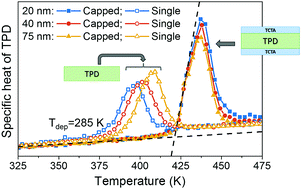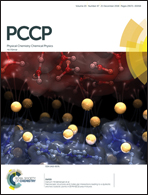Kinetic arrest of front transformation to gain access to the bulk glass transition in ultrathin films of vapour-deposited glasses†
Abstract
Physical vapour deposition has emerged as the technique to obtain glasses of unbeatable stability. However, vapour deposited glasses exhibit a different transformation mechanism to ordinary glasses produced from liquid. Vapour deposited glasses of different thermodynamic stability, from ultrastable to those similar to ordinary glasses, transform into the liquid state via front propagation starting at the most mobile surfaces/interfaces, at least for the first stages of the transformation, eventually dynamiting the high thermal stability achieved for some of these glasses. A previous study showed that it was possible to avoid this transformation front by capping the films with a higher Tg material. We show here fast calorimetry measurements on TPD and IMC vapour deposited glasses capped respectively with TCTA and TPD. This capped configuration is very effective in suppressing the heterogeneous transformation of the stable glasses into the supercooled liquid and shifts the devitrification temperature to much higher values, where the bulk homogeneous mechanism becomes active. This approach may be useful to further study the bulk glass transition in thin films.



 Please wait while we load your content...
Please wait while we load your content...